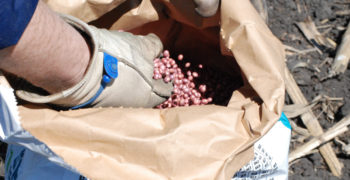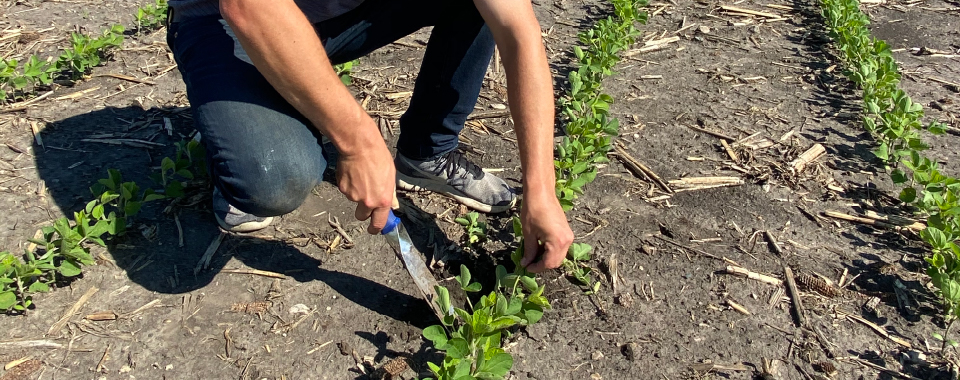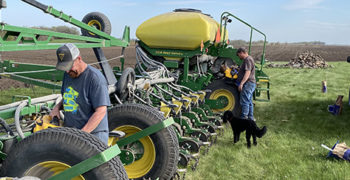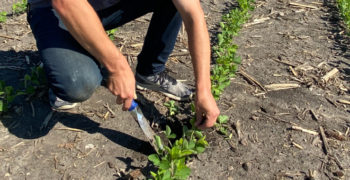You see disease scores in Champion Seed product guides and tech sheets. What do they really mean for soybean product selection? Are they necessary? Do they impact every grower and every field?
Crop scouting records, field history, farming practices and even local weather trends can help us select the most successful soybean variety based on your farm.
Here are some tips to help you decipher if the disease ratings apply to your needs.
Phytophthora Root Rot (PRR)
PRR can happen anytime in the growing season when soils are warm and saturated. PRR includes seed rot, damping off, and pre- and post-emergence blight.
Are the soybeans going to be no-till planted? A soybean variety with a good PRR score is recommended in no-till fields because the soil can remain wet longer.
Is the field well-drained? Growers can often get by without a strong PRR score in well-drained soils.
Will a fungicide seed treatment be used? Fungicide seed treatments can protect seeds and seedlings from PRR throughout the early growing season.
Iron Chlorosis Deficiency (IDC)
If IDC is going to show up, it always happens from V1 to V3. IDC occurs because the soybean plant is unable to use the iron in the soil. This can happen because of high nitrate carryover, high pH and/or herbicide stress on the plant.
What is the soil pH? The availability of iron begins to decrease at a pH of 6 and is nearly unavailable to the plant at 8.5.
What is the planting rate? Higher planting rates can reduce the incidence of IDC.
How much nitrogen has been used previously? Nitrate carryover from the previous year’s corn can tie up iron.
Will a cover crop be used? The use of a cover crop can reduce nitrate carryover.
Could there be herbicide carryover from last year’s corn? Herbicide stress can aggravate IDC.
Brown Stem Rot (BSR)
BSR prefers to survive in soybean residue, but it can also survive in the soil for about three years after soybeans. BSR is more severe when it is cool and wet early and then turns hot and dry later during the reproductive stages.
Will the soybeans be planted early? Early planted soybeans are more likely to experience cool, wet conditions, which favor infection of BSR.
Is this rotated ground or has it been corn-on-corn for three or more years? Three or more consecutive years of a non-host crop can greatly reduce the incidence of BSR.
Will the soybeans be no-till planted? Tillage can reduce the incidence of BSR by burying crop residue and allowing the soil to warm up more rapidly.
White Mold (WM)
White mold is a soil-borne pathogen that is more prevalent in humid and cool conditions. It usually shows up during the reproductive stages when soybeans are at full canopy. It can be most severe when soybeans are lodged or the soil remains wet for long periods.
What is the fertility level? High fertility can cause soybeans to get tall and full, resulting in lodging and high humidity under the canopy. A soybean variety with an excellent lodging score should be planted in high- fertility fields.
What is the intended row spacing and planting population? Decreasing populations can increase standability. Wider rows usually allow for airflow under the canopy, reducing the length of time with high humidity.
Will the field be tilled? Even if more mold is found under crop residue, leaving white mold undisturbed or a two-year rotation to a non-host crop will reduce the amount.
Sudden Death Syndrome (SDS)
The incidence of SDS is more favorable with wet, cool conditions early in the growing season coupled with compaction, soybean cyst nematode or anything that causes early root damage. A big late season rain during the reproductive stages also increases the severity.
Will the beans be planted early? Early planted soybeans are more likely to experience cool, wet conditions, which favor infection of SDS.
Is the operator willing/able to delay planting when field conditions are unfavorable? Tillage and planting in wet conditions will increase compaction.
Will the soybeans be treated with Elevate VIP? This treatment option contains Saltro, which can greatly reduce the incidence of SDS.
Frogeye Leaf Spot (FE)
FE hangs out in soybean residue and is most prevalent in warm and humid conditions for the infection of soybean leaves. Rotation with corn or a non-host crop, plus tillage, can reduce the survival rate of the pathogen in the field.
Will the field be sprayed with a foliar fungicide? The use of a fungicide with multiple modes of action can be effective in suppressing FE.
Is it a continuous soybean field? A soybean variety with a strong resistance to FE may be required in continuous soybean fields.
Has the field been historically no-till planted? FE resides in crop residue, primarily soybean residue. Tillage can greatly reduce the incidence of FE.
Stem Canker (SC)
SC is another fungus that infects the soybean plant early in the growing season, but the symptoms are not visible until the reproductive stages. An extended period of wet conditions can cause infection, followed by a rain event in which the leaves remain wet for more than 24 hours. Temperatures that favor further infection of the pathogen range from 70 degrees to 85 degrees.
What are the tillage practices for the field? Tillage can reduce the survival of the pathogen.
When will the field be planted? Delayed planting can reduce the incidence of early infection.
If a variety is missing some of the disease scores, does that mean it’s a bad product option? The answer is no.
 TRY OUR EASY ONLINE PRODUCT CATALOG
TRY OUR EASY ONLINE PRODUCT CATALOG
View our soybean variety disease scores in our online product catalog. Simply select the soybean trait you desire, adjust to the maturity range that fits your region and click on the header of the disease you are most concerned about. The best product suggestions will filter to the top.



